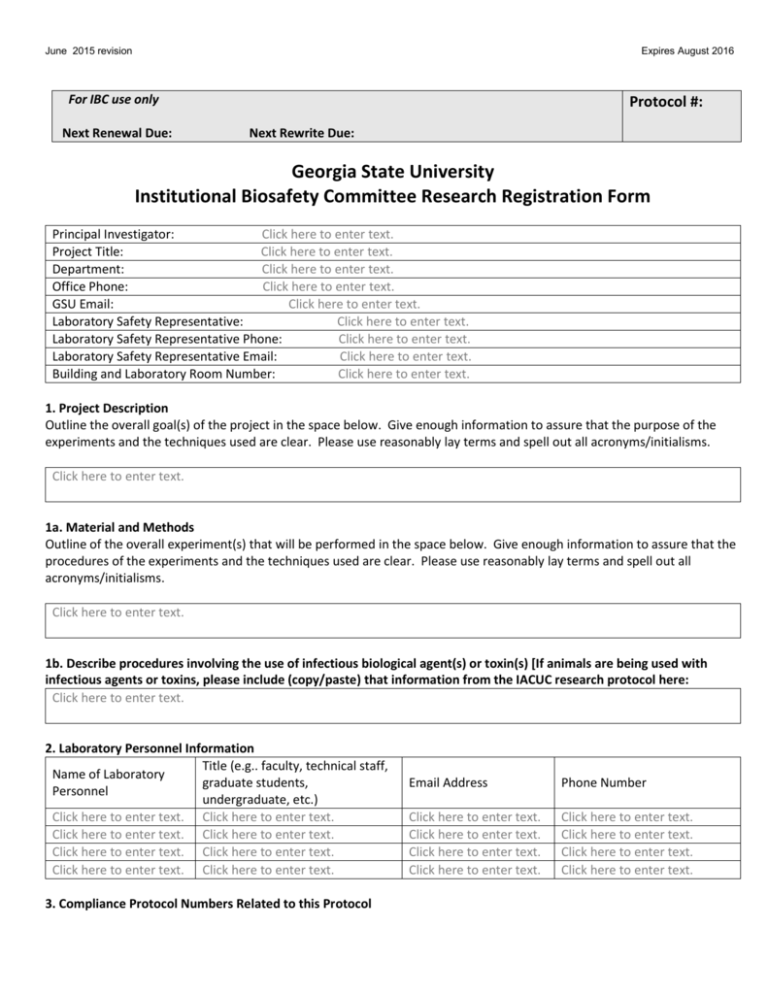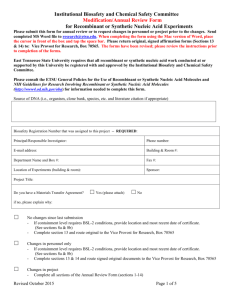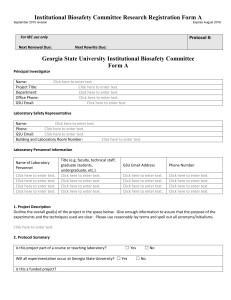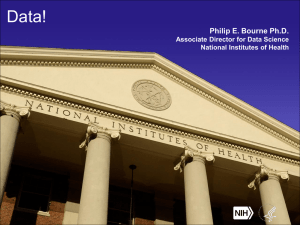Other: Click here to enter text.
advertisement

June 2015 revision Expires August 2016 For IBC use only Next Renewal Due: Protocol #: Next Rewrite Due: Georgia State University Institutional Biosafety Committee Research Registration Form Principal Investigator: Click here to enter text. Project Title: Click here to enter text. Department: Click here to enter text. Office Phone: Click here to enter text. GSU Email: Click here to enter text. Laboratory Safety Representative: Click here to enter text. Laboratory Safety Representative Phone: Click here to enter text. Laboratory Safety Representative Email: Click here to enter text. Building and Laboratory Room Number: Click here to enter text. 1. Project Description Outline the overall goal(s) of the project in the space below. Give enough information to assure that the purpose of the experiments and the techniques used are clear. Please use reasonably lay terms and spell out all acronyms/initialisms. Click here to enter text. 1a. Material and Methods Outline of the overall experiment(s) that will be performed in the space below. Give enough information to assure that the procedures of the experiments and the techniques used are clear. Please use reasonably lay terms and spell out all acronyms/initialisms. Click here to enter text. 1b. Describe procedures involving the use of infectious biological agent(s) or toxin(s) [If animals are being used with infectious agents or toxins, please include (copy/paste) that information from the IACUC research protocol here: Click here to enter text. 2. Laboratory Personnel Information Title (e.g.. faculty, technical staff, Name of Laboratory graduate students, Personnel undergraduate, etc.) Click here to enter text. Click here to enter text. Click here to enter text. Click here to enter text. Click here to enter text. Click here to enter text. Click here to enter text. Click here to enter text. 3. Compliance Protocol Numbers Related to this Protocol Email Address Phone Number Click here to enter text. Click here to enter text. Click here to enter text. Click here to enter text. Click here to enter text. Click here to enter text. Click here to enter text. Click here to enter text. Principal Investigator: Protocol # Radiation Safety Protocol No(s): IRB Protocol No(s): IBC Protocol No(s): Click here to enter text. Click here to enter text. Click here to enter text. 4. Protocol Summary ☐ BSL-1 ☐ BSL-2 ☐ BSL-3 ☐ BSL-4 ☐ Does Not Apply Is this project part of a course or teaching laboratory? ☐ Yes ☐ No Will live animals be used for this project? ☐ Yes ☐ No IACUC protocol associated with this project: Click here to enter text. Animal Biosafety Level: ☐ ABSL-1 ☐ ABSL-2 ☐ ABSL-3 ☐Fish ☐Lizards ☐Mice ☐Rats ☐Hamsters ☐Birds ☐Non-Human Primates ☐Cell Lines ☐ Primary cell lines ☐Other Click here to enter text. ☐ Venomous Invertebrates or Vertebrates What type of wastes will be generated? Biosafety Level: (Check all that apply) ☐ Biohazardous Waste ☐ Mixed radioactive/biological Is this a funded project? ☐ Chemical ☐ National Institute of Health (NIH) ☐ National Science Foundation (NSF) ☐ Department of Agriculture (USDA) ☐ Does Not Apply ☐Insects ☐ Radiological ☐ Mixed chemical/biological ☐ Department of Defense (DoD) ☐ Centers for Disease Control and Prevention (CDC) ☐ Other Will this project involve: ☐ Human Material (Blood, Saliva, Urine, etc.) ☐ Non-Human Primates Material (Blood, Salvia, Urine, etc.) ☐ Select Agents or Toxins ☐ Bacterial Agents ☐ Viral Agents ☐ Possible Blood Borne Pathogens ☐ Rickettsia Agents ☐ Plants ☐ Fungal Agents ☐ Toxic Agents from Microorganisms/Animals ☐ Prions ☐ Arboviruses and Related Zoonotic Viruses ☐ Recombinant or Synthetic Nucleic Acid Molecules: ☐ that encodes and expresses toxins ☐ that encodes and expresses proteins ☐ from a USDA regulated plant or animal ☐ Moving non-indigenous species of plants or animals (including offspring) into Georgia? ☐ Moving pathogens that adversely affect plants or animals into Georgia? ☐ Moving indigenous species of plants or animals infected with pathogenic microorganisms Into or out of Georgia? ☐ Does Not Apply 5. Are you growing more than 10 liters of recombinant material or any type of cultures? If yes, please identify the building, room, and type of equipment used for large scale culture growth in the block below? ☐ Yes ☐ No ☐ Does Not Apply June 2015 revision Expires August 2016 Principal Investigator: Protocol # Click here to enter text. 6. Georgia State University Laboratory Policies (for any questions in which you answer “NO” please explain) Laboratory Sign on door has the Universal Biohazardous Symbol, Biosafety Level, Principal Investigator’s Name and Phone Number. Eating, drinking, smoking, handling contact lenses, applying cosmetics, and storing of food for human consumption is prohibited in the laboratory. Procedures describing the appropriate personal protective equipment required for entering and exiting the laboratory are posted near the door. Laboratory-specific Biosafety manual is prepared, adopted, available and accessible. Laboratory equipment is routinely decontaminated with the appropriate disinfectant described below in Section 3a: Method(s) of Disinfection: Click here to enter text. All procedures are performed to minimize the creation of splashes and/or aerosols. All procedures involving the manipulations of infectious material that may generate an aerosol will be conducted within a Biosafety Cabinet (vortexing, sonicating). Principal Investigator will provide information regarding immune competence and conditions that may predispose laboratory personnel to infections. Incidents resulting in exposure to infectious materials will be immediately reported to the Biosafety Officer (404-413-3510). Only plants and animals associated with the work being performed will be allowed in the laboratory. Vacuum lines have HEPA filters in place before vacuum pump or the vacuum valve. Emergency Chart and Call Down list are posted in the Laboratory. Policies for safe handling of sharps are posted. Broken glassware is removed using a dust pan, brush, tongs, forceps or other mechanical means. Proper gas tubing is being used in with Bunsen Burners. Compressed Gas Cylinders are properly secured. All Mercury Thermometers have been replaced with non-mercury thermometers ( http://www.gsu.edu/research/59296.html ) unless otherwise specified in this IBC protocol. A Chemical Hygiene Plan is prepared, and adopted, available and accessible. All chemical waste will be removed through scheduled pick up by GSU Environmental Programs Group ( https://chematix.gsu.edu/Chematix/ ). Only soap and water will be allowed down the sink drains in the laboratory. Hazardous Waste Containers are properly labeled. Safety Data Sheet (SDS) access is available through Chematix. Chemicals are properly stored and inventoried in Chematix. Eye and face protection (goggles, mask, face shield or other splatter guard) is used for anticipated splashes or sprays of infectious or other hazardous materials when the microorganisms must be handled outside the BSC or containment device. Gloves must be worn to protect hands from exposure to hazardous materials. All toxins and DEA Controlled Substances are semi-annually inventoried by the Principal Investigator or designee in Chematix and/or document controlled inventory (electronically encrypted inventory or paperbound log book that is physically locked in a key controlled cabinet). Will you follow all of the 49 CFR 171 requirements for the shipment of biological material as specified in GSU Shipment of biological Materials Manual Yes No ☐ ☐ ☐ ☐ ☐ ☐ ☐ ☐ ☐ ☐ ☐ ☐ ☐ ☐ ☐ ☐ ☐ ☐ ☐ ☐ ☐ ☐ ☐ ☐ ☐ ☐ ☐ ☐ ☐ ☐ ☐ ☐ ☐ ☐ ☐ ☐ ☐ ☐ ☐ ☐ ☐ ☐ ☐ ☐ ☐ ☐ ☐ ☐ ☐ ☐ ☐ ☐ 7. The biosafety cabinets and laboratory benches will be disinfected by: June 2015 revision Expires August 2016 Principal Investigator: Protocol # Ethanol, 70% with a 15 minute contact time. Freshly made 1:10 solution of bleach (5% or more of the active ingredient, sodium hypochlorite) with a 3 minute contact time. Glutaraldehyde solution with a 10 minute contact time. Name commercial disinfectant here: Click here to enter text. Ortho-phthalaldehyde solution with a 5 minute contact time. Name commercial disinfectant here: Click here to enter text. Other method of disinfecting and contact time. Name disinfectant here: Click here to enter text. Yes ☐ No ☐ ☐ ☐ ☐ ☐ ☐ ☐ ☐ ☐ Yes ☐ ☐ ☐ No ☐ ☐ ☐ ☐ ☐ ☐ ☐ ☐ ☐ 8. Waste Materials will be sterilized by: o Autoclave: 15 minutes at 121 C (15 PSI) Autoclave: 30 minutes at 121°C (15 PSI) Autoclave: 45 minutes at 132°C (15 PSI) Incineration of infectious material and/or animal carcasses: http://ursa.research.gsu.edu/files/2013/04/Biohazardous_Waste_Disposal.pdf Sharps containers will be incinerated according to GSU policies: http://ursa.research.gsu.edu/files/2013/03/Sharps-Disposal-Procedures.pdf List other method of Sterilization: Click here to enter text. 9. Laboratory Equipment and Personal Protective Equipment Will Laboratory Workers require: ☐ Pre-project and Post-project serum samples ☐ Immunizations: ☐ Hepatitis B (check all that apply) ☐ Proof of MMR ☐ Medical Affiliation : Monitoring ☐Division of Animal Resources Surveillance (check here if you have an IACUC protocol) or ☐ Influenza (seasonal) ☐ Tetanus ☐ Other: Click here to enter text. ☐ BSL-4 (high containment laboratory) (check here if you work in the BSL-4) ☐ N-95 Masks, PAPRs, or other respiratory equipment Note: Building/ Room(s) Click here to enter text. Click here to enter text. Surgical Masks are to prevent fecal-oral exposure to infectious agents. N-95 Masks and PAPRs are to prevent exposure to dust, animal dander, and infectious aerosols. Biosafety Level BSL-1 Required: Laboratory Coat BSL-1 Recommended: ☐ Gloves ☐ Safety Glasses/Side shields/Safety Goggles ☐ Biosafety Cabinet ☐ Fumehood ☐ Off-campus location (check here if samples will be collected/experimentation will not be done at GSU) BSL-2 Required: Laboratory Coat, Gloves, Safety Glasses/Side shields/Safety Goggles BSL-2 Recommended: ☐Booties ☐ Surgical Mask ☐ N-95 Mask ☐ PAPR ☐ Fumehood ☐ Biosafety Cabinet ☒ Other: Click here to enter text. June 2015 revision Expires August 2016 Principal Investigator: Click here to enter text. BSL-3 Required: Laboratory Coat or closed front Gown, or Scrubs, 2 Pairs of different colored Gloves, Safety Glasses/Side shields/Safety Goggles, Booties BSL-3 Respiratory Protection: ☐ N-95 Mask ☐ PAPR Click here to enter text. Click here to enter text. Click here to enter text. Click here to enter text. Protocol # ☐ Other: Click here to enter text. BSL-4 Required: Laboratory Coat, 2 Pair of Gloves, Safety Glasses/Side shields/Safety Goggles, Booties Scrubs BSL-4 Recommended: ☐ N-95 Mask ☐ Tyvek w/ hood and foot covers ☐ PAPR ☐ Other: Click here to enter text. ABSL-1 Required: Laboratory Coat and/or Gown, Gloves ABSL-1 Recommended: ☐ Surgical Mask ☐ N-95 Mask ☐ PAPR ☐ Cage Change Station ☐ Other: Click here to enter text. ABSL-2 Required: Laboratory Coat or Scrubs and Gown, Gloves, Safety Glasses/Side shields/Safety Goggles, Booties, Biosafety Cabinet ABSL-2 Recommended: ☐ Surgical Mask ☐ N-95 Mask ☐ PAPR ☐ Other Click here to enter text. ABSL-3 Required: Biological Safety Cabinet, Scrubs, Tyvek® Cover Up or equivalent, Gloves with cuffs, PAPR, Booties Tyvek® Cover Up = Tyvek suit with hood and foot covers (all in one) ☐SCBA ☐ Other: Click here to enter text. 10. Are you working with genetic elements, recombinant nucleic acids, recombinant DNA (rDNA) or recombinant organisms? ☐ Yes ☐ No If yes, you must complete questions 11a-11e. If no, go to question 12. If yes, you must complete NIH required Biosafety training. Yes Have you completed the NIH required Biosafety training? ☐ Contact eprograms@gsu.edu for access to the online Biosafety training found here Are you deliberately transferring a drug resistance trait to microorganisms that are not known to acquire the trait naturally? ☐ See Section III-A-1-a of the NIH Guidelines for more information. Are you deliberately producing recombinant or synthetic nucleic acid containing genes for the biosynthesis of toxin molecules lethal for vertebrates at an LD50 of less than 100 nanograms per kilogram body weight (e.g., microbial toxins such as the botulinum toxins, tetanus toxin, diphtheria toxin, and ☐ Shigella dysenteriae neurotoxin). See Section III-B-1 of the NIH Guidelines for more information. Are you deliberately transferring Recombinant or Synthetic Nucleic Acid Molecules, or DNA or RNA derived from Recombinant DNA or Synthetic Nucleic Acid Molecules, into human research participants? ☐ See Section III-C-1of the NIH Guidelines for more information. Are you performing experiments Using Risk Group 2, Risk Group 3, Risk Group 4, or Restricted Agents as Host-Vector Systems? ☐ See Section III-D-1of the NIH Guidelines for more information. Are you performing experiments in which DNA from Risk Group 2, Risk Group 3, Risk Group 4, or Restricted Agents is cloned into Nonpathogenic Prokaryotic or Lower Eukaryotic Host-Vector Systems? ☐ See Section III-D-2 of the NIH Guidelines for more information. Are you performing experiments involving the use of Infectious DNA or RNA Virus or Defective DNA or ☐ RNA Viruses in the presence of Helper Virus in Tissue Culture System? June 2015 revision No ☐ ☐ ☐ ☐ ☐ ☐ ☐ Expires August 2016 Principal Investigator: Protocol # See Section III-D-3 of the NIH Guidelines for more information. Are you performing experiments involving Whole Animals that include either: ABSL-2 (medium level) or ABSL-3 (high level) containment; and altering the animals genome by introduction of recombinant or synthetic nucleic acid molecules or nucleic acids derived therefrom, into germ-line (transgenic animals); or ☐ Yes ☐ No exposing whole animals to recombinant or synthetic nucleic acid molecules or nucleic acid molecules-modified microorganisms? ☐ Yes ☐ No See Section III-D-4 of the NIH Guidelines for more information. Are you performing experiments involving Whole Plants? See Section III-D-5 of the NIH Guidelines for more information. Are you performing experiments involving More than 10 Liters of culture? See Section III-D-6 of the NIH Guidelines for more information. Are you performing experiments involving Influenza Viruses including but not limited to: generating influenza viruses from recombinant or synthetic methods; ☐ Yes ☐ No reverse genetics of chimeric viruses with reasserted segments; ☐ Yes ☐ No introduction of specific mutations; ☐ Yes ☐ No using Human H2N2 (1957-1968); ☐ Yes ☐ No using Highly Pathogenic Avian Influenza H5N1strains; ☐ Yes ☐ No using 1918 H1N1; or ☐ Yes ☐ No testing antiviral susceptibility? ☐ Yes ☐ No See Section III-D-7 of the NIH Guidelines for more information. Are you performing experiments involving the Formation of Recombinant DNA Molecules Containing No More than Two-Thirds of the Genome of any Eukaryotic Virus? See Section III-E-1 of the NIH Guidelines for more information. Are you performing experiments involving Whole Plants? See Section III-E-2 of the NIH Guidelines for more information. Are you performing experiments involving Transgenic Rodents that: only require ABSL-1(low level) containment; and that include altering the animals genome by introduction of recombinant or synthetic nucleic acid molecules or nucleic acids derived therefrom, into germ-line (transgenic animals)? See Section III-E-3 of the NIH Guidelines. Are you performing experiments that present a significant risk to health or the environment? See Section III-F-8 of the NIH Guidelines for more information. ☐ ☐ ☐ ☐ ☐ ☐ ☐ ☐ ☐ ☐ ☐ ☐ ☐ ☐ ☐ ☐ Exempt Experiments: The following recombinant or synthetic nucleic acid molecules are exempt from the NIH Guidelines; however, other federal and state standards of biosafety may still apply to such research (for example, the Centers for Disease Control and Prevention (CDC)/NIH publication Biosafety in Microbiological and Biomedical Laboratories) Are you performing experiments that include synthetic nucleic acids that: can neither replicate nor generate nucleic acids that can replicate in any living cell; and are not designed to integrate into DNA; and do not produce a toxin that is lethal for vertebrates at an LD50 of less than 100 nanograms per kilogram body weight? See Section III-F-1 of the NIH Guidelines for more information. Are you performing experiments that are: not in organisms, cells, or viruses; and that have not been modified or manipulated to render them capable of penetrating cellular membranes? See Section III-F-2 of the NIH Guidelines for more information. June 2015 revision ☐ ☐ ☐ ☐ Expires August 2016 Principal Investigator: Protocol # Are you performing experiments that consist solely of the exact recombinant or synthetic nucleic acid sequences from a single source that exists contemporaneously in nature? See Section III-F-3 of the NIH Guidelines for more information. Are you performing experiments that consist entirely of nucleic acids from a prokaryotic host including its indigenous plasmids or viruses when propagated only in that host (or a closely related strain of the same species), or when transferred to another host by well-established physiological means? See Section III-F-4 of the NIH Guidelines for more information. Are you performing experiments that consist entirely of nucleic acids from an eukaryotic host including its chloroplasts, mitochondria, or plasmids (but excluding viruses) when propagated only in that host (or a closely related strain of the same species)? See Section III-F-5 of the NIH Guidelines for more information. Are you performing experiments that consist entirely of DNA segments from different species that exchange DNA by known physiological processes, though one or more of the segments may be a synthetic equivalent? See Section III-F-6 of the NIH Guidelines for more information. Are you performing experiments with those genomic DNA molecules that have acquired a transposable element, provided the transposable element does not contain any recombinant and/or synthetic DNA? See Section III-F-7 of the NIH Guidelines for more information. ☐ ☐ ☐ ☐ ☐ ☐ ☐ ☐ ☐ ☐ 11. Specify the Recombinant or Synthetic Nucleic Acid Molecules, including as much information as possible about: nature of the insert; protein that may be expressed; percentage of any viral genome in the construct; cloning/expression/transfection vectors used; recipient host cell lines (human, animal, plant, etc.) or bacterial strains; packaging cell lines and assay system used to measure helper virus titre or titre of replication competent virus (background) generated; host range of packaged viral vector; and expected phenotype of the animal if applicable, including any expected behavioral traits, disease predispositions, or health problems. Click here to enter text. 12. Are you are working with biological material that may be infectious or a toxin? ☐Yes ☐No If yes, then you must complete 12. If No, then go to question 13. 12a. Will the Biological Agent(s) / Microorganism(s) / Toxin(s) be: ☐ Cultured from Human Tissue or Blood? ☐ Cultured from Animal Tissue or Blood? ☐ Cultured from an Environmental Sample such as air, water, soil, or plants? ☐ Cultured by a Principal Investigator from Georgia State University? If yes, what is the name of the PI: Click here to enter text. ☐ Cultured in a laboratory outside of Georgia State University? If yes, what is the name of the PI and the Laboratory: Click here to enter text. ☐ Cultured in human/animal cell lines? Click here to enter text. ☐ Does Not Apply June 2015 revision Expires August 2016 Principal Investigator: Protocol # 12b. Name the Biological Agents(s)/Microorganism(s), Biosafety Level, and “X” the source. ☐ ☐ ☐ ☐ ☐ ☐ ☐ ☐ ☐ ☐ ☐ ☐ ☐ ☐ Click here to enter text. # ☐ ☐ ☐ ☐ ☐ ☐ ☐ ☐ ☐ ☐ ☐ ☐ ☐ ☐ ☐ VWR ☐ Univ. of GA Click here to enter text. Georgia Tech ☐ ☐ ☐ ☐ ☐ ☐ ☐ ☐ ☐ ☐ ☐ ☐ ☐ ☐ Georgia State Univ. ☐ # Roche Click here to enter text. Qiagen ☐ ☐ ☐ ☐ ☐ ☐ ☐ ☐ ☐ ☐ ☐ ☐ ☐ ☐ NEB ☐ # Fisher Scientific Click here to enter text. Fermentas ☐ ☐ ☐ ☐ ☐ ☐ ☐ ☐ ☐ ☐ ☐ ☐ ☐ ☐ EMD ☐ # BioRad Addgene # Agilent/ Stratgene Blood borne Pathogens or other potentially infectious material Click here to enter text. Biological Agent(s) / Microorganism(s) / Toxin(s) and Strains ATCC Biosafety Level (1, 2, 3, or 4) Source or Origin: Click here to enter text. Other: Click here to enter text. 13. Are you working with a Human Source or Non-Human Primate Material? ☐Yes ☐No. If yes, you must complete Question 13. If no, go to question 14. Has everyone in the laboratory completed the online Bloodborne Pathogen Training Course for the Board of Reagents of the University System of Georgia? ( http://www.usg.edu/ehs/training/pathogens/ ) Was a health screening done on the source material? If yes, please attach a copy of the report. Will human and/or non-human primate material be administered to animals? If you are using biological material that may contain Bloodborne Pathogens, do you have an Exposure Control Plan (ECP) on file with the Office of Biosafety and/or Safety and Risk Management? If Human Source or Non-Human Primate Material is being used, has the material been treated prior to use in the laboratory (such as formalin fixing or heat treatment)? Will you be using any of the following Human and/or Non-Human Primate Biological Material: ☐ Blood ☐ Serum ☐ Cells ☐ Cell Culture ☐ Tissue ☐ Feces ☐ Saliva ☐Hair ☐ Other: Please list here: Click here to enter text. ☐ Urine Yes ☐ No ☐ ☐ ☐ ☐ ☐ ☐ ☐ ☐ ☐ ☐ ☐ ☐ Bones 14. Are you working with a Select Agent or Toxin? ☐Yes ☐No. If yes, please explain. If no, go to Section 15. Click here to enter text. 15. Certification and Signatures June 2015 revision Expires August 2016 Principal Investigator: Protocol # The information contained in this application is accurate and complete. I am familiar with and agree to abide by the provisions of the current NIH Guidelines, the NIH Guide for Grants and Contracts, other specific NIH instructions pertaining to the proposed project, local, state and federal regulations, and any applicable GSU policies and procedures. In addition, I agree to abide by the following requirements: a. I will initiate no recombinant DNA research subject to the NIH Guidelines until that research has been reviewed and approved/registered with the Institutional Biosafety Committee (IBC). b. I will follow appropriate biosafety level laboratory techniques in the research. c. I will comply with all shipping requirements for biological materials. d. I will make available to the laboratory staff copies of the approved protocols that describe the potential biohazards and the precautions to be taken. e. I will train staff in: good microbiological practices and techniques required to ensure safety for this project, in the procedures for dealing with accidents, and in waste management procedures. f. I will supervise staff, correct work errors, and conditions that could result in breaches of the NIH Guidelines, local, state or federal regulations, or any applicable GSU policies or procedures. I acknowledge the reporting requirements of the NIH Guidelines recombinant DNA spills. Specifically, Section IV-B2-b-(7) of the NIH Guidelines requires that any significant problems or violations of the NIH Guidelines and any significant research related accidents or illnesses to the appropriate institutional official and the NIH OBA within 30 days. Appendix G ( http://oba.od.nih.gov/oba/rac/guidelines_02/Appendix_G.htm )of the NIH Guidelines specifies certain types of accidents that must be reported on a more expedited basis. Spills or accidents in BSL-2 laboratories resulting in an overt exposure must be immediately reported to NIH OBA, as must overt or potential exposure in high containment (BSL-3 and BSL-4) laboratories. g. By signing or marking the electronic signature block below, I certify that I have read and understood this form and that the information I have provided is true to the best of my knowledge. Further, I agree to adhere to the requirements within this document and understand that I will be held responsible and may be subject to disciplinary action, for any omissions or misrepresentations. Principal Investigator (type name above) ☐Check for electronic signature. The file can then be returned via email to Biosafety Officer at rmuller1@gsu.edu. Date GSU Biosafety Officer Date IBC Chair Date June 2015 revision Expires August 2016









